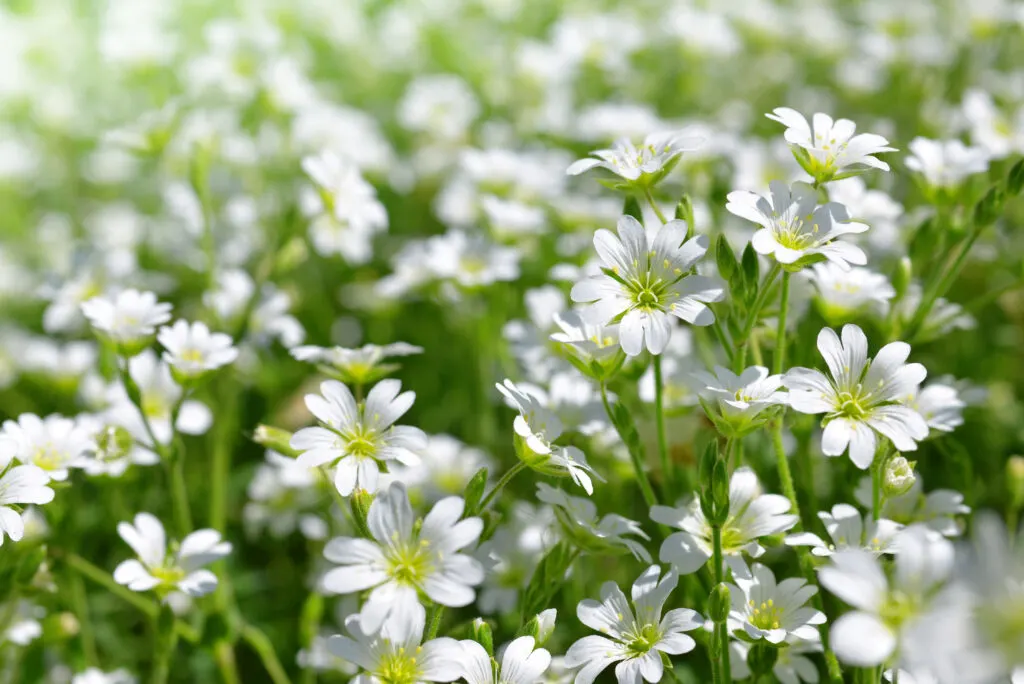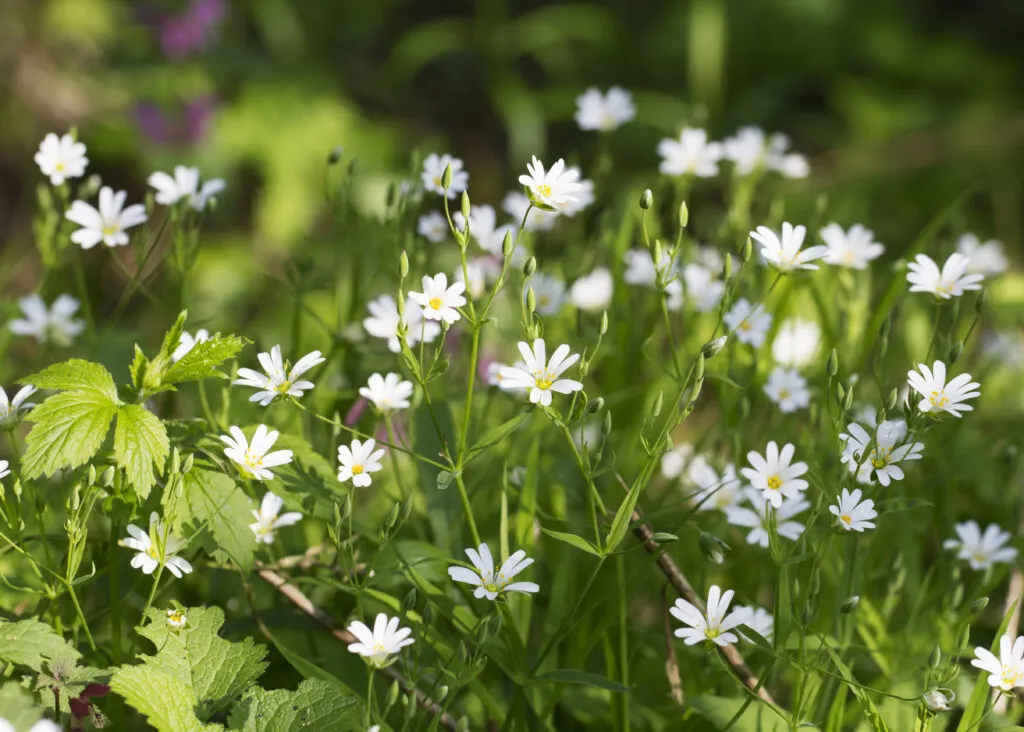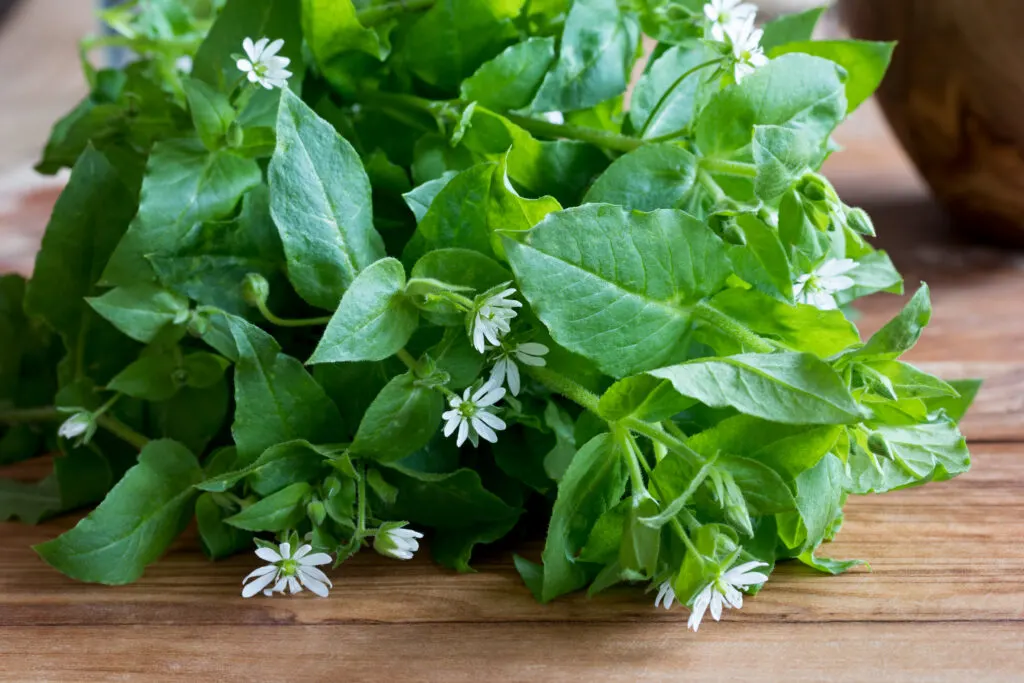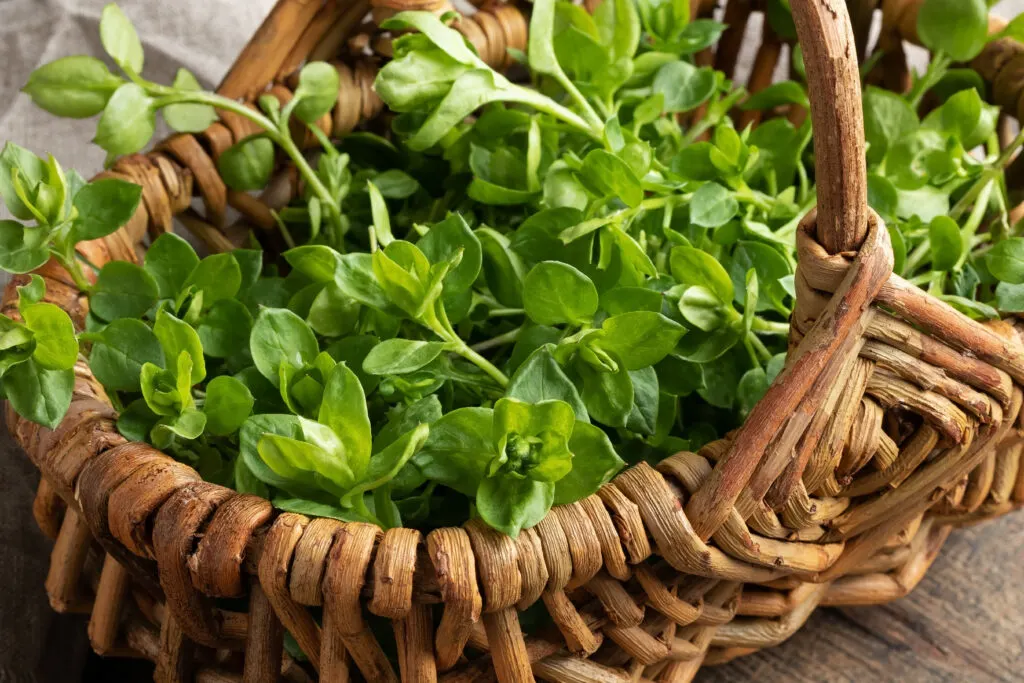Disclaimer: This website contains affiliate links, from which Heritage Acres Market LLC may receive a small commission from the vendor on the sales of certain items, all at no cost to you. Please read our full disclosure for more information. Thank you for supporting Heritage Acres Market LLC!
Guest post written by Heather from The Herbal Academy
Chickweed (Stellaria media) grows in slightly disturbed places, such as your garden, fallow fields, the edge of pathways and trails, or under greenhouse benches. You probably will not find very much of it near any occupied hen house though, because chicks love it! However, once you learn why, you may decide to grow chickweed for chickens!
Birds eat chickweed preferentially and for good reason.
Chickweed, Stellaria media, is also called starflower, stitchwort, star weed, starwort, tongue grass, and adders mouth, carpetweed, winterweed, and chickenwort, all suitable names!
But wait, it is also called “the hen’s inheritance”! Chickweed for chickens is the crème de la crème.

Table of Contents
Chickweed- The Essential Facts
Chickweed (Stellaria medii), grows as a groundcover, slightly vining, with many small ½ long or shorter oval leaves arranged in opposite pairs along the stem. These leaves are tiny but have a thickness, texture, scent, and even taste somewhat like spinach—and we can eat it like spinach too, raw in salads or sandwiches much as you might use alfalfa or other sprouts!
Chickweed is rich in minerals, including calcium, magnesium, potassium, iron, zinc, manganese, silicon, and most notably copper. When your hens are eating chickweed not only can it bolster their health, the eggs they produce may be particularly nutrient-rich, in ways that matter the most to many.
Chickweed is rich in omega-6 fatty acids, often called the healthier or anti-inflammatory type of omega fatty acid. Many people consume omega-6 fatty acids as a supplement, usually in the form of fish oil, though there are plant (or rather algae) sources as well. This is the type of omega fatty acid that occurs in leaf fats as opposed to seed fats. Furthermore, it is concentrated in the meat and eggs of animals that are either free-range or feed on grass and leafy plants, as opposed to solely grains, such as corn. So in many ways, chickweed is good for the birds and good for us too!
So how do you go about knowing if you have this plant growing? Starflower is named for what appear to be ten small white petals that grow in five pairs (these are actually five bifid petals), hugged by a calyx that is often a bit longer and more substantial than the petals.
You might call the flower inconspicuous, it is only ¼ inch broad at most and everything about it is slight. The seeds are small, dense, and round, similar to mustard seeds, and equally copious! Find out more and see some identification and harvesting tips in

Herbal Uses for Chickweed
Herbalists are familiar with chickweed as a demulcent ingredient to be included in salves, or used as a poultice. Also, this nutritious plant can be found during almost any season. I have often stumbled upon patches of it still green, live, and hearty in winter fields—in places where the snow and ice are just a little bit scarcer—hence the alternate common name ‘winterweed’.
It would not be surprising at all to find additional common names alluding to chickweed’s winter presence and tenacity. Herbalists also know it as a nutritive herb, so much so that it is sometimes used in infusions to support someone during convalescence.
Interestingly, chickweed is also a diuretic, and sometimes called a diet or weight loss herb. Although, this probably has more to do with potential support of healthy fluid balance by way of the minerals and electrolytes it contains in spades.
Those minerals in what we often call nutrient-rich herbs also support energy, so that someone may experience better vitality, feel more nourished, and less sluggish. We can eat chickweed in infusions, salads, sandwiches, and use it to make a variety of herbal preparations. Or, dry it to use as a mineral-rich tea in the winter.
Read more about foraging and using chickweed for humans, nutrient-rich herbs, herbs for deep nourishment, and foraging wild foods in any of these articles from the

Why Chickweed for Chickens?
Now let’s talk about why there is a strong association of chickweed for chickens (the hen’s inheritance!) and why it is also associated with the care of many farm animals.
First of all, just based on observation, chickens love it! You may know that chickens have great instincts for what they need! One homesteader suggested that you might not find so much chickweed around if you have hens, because, well, they have eaten every scrap of it.
You might like to seed, encourage, or gather it from a neighbor’s garden (who probably will not protest if you ask first!). Chickweed can also be used as a cover crop, particularly in small-scale gardening, because it is easy to mow, cut back, or pull by hand, in comparison to many other weeds and crops.
Chickens go for chickweed based on nutrition—that richness of minerals and fats. Also, it’s ease of grazing is a huge plus. The youngest chicks will be able to peck at and eat chickweed with ease, as it is soft, small, low, and easy to digest for a whole range of critters.
Based on its demulcent quality it is also considered gut healing, though I can’t say whether that is of real benefit to an avian digestive tract. However, for what it’s worth, countless enthusiasts seem to think so and report its generally healing properties for chicks and grown birds in any sort of distress. For birds, there is no toxicity associated with chickweed. Yet, it is rich in, or perhaps accumulates, copper—a fact worth noting should there be risk or concern.
Related: Listen to the interview with Heather from The

Chickweed Resources and Reading
There are many sources old and new. We could draw on further knowledge, but my favorite authority on herbs for animal care is Juliette de Bairacli Levy, a famous herbalist. She attended veterinary school but later diverged to learn country shepherd remedies directly from traditional practitioners throughout Europe, Turkey, Greece, and North Africa, in particular the Romani people. She lived, practiced, and taught in the US at times as well. Juliette also urges us to use chickweed for chickens. Here are some words about chickweed from her book: The Complete Herbal Handbook for Farm and Stable.
“All animals should be encouraged to feed upon it; but sheep must be prevented from over-gorging themselves, especially lambs, or severe digestive upset can follow owing to the richness of these herbs.” (de Bairacli Levy, 1991, p. 49)
In the Herbs for Animals Intensive through The Herbarium we can also confirm themes learned from folk use, by learning that chickweed is used to support internal and external tissue healing, especially in cases of inflammation. In addition, it supports the lymphatic system.
These are among the ways it is used for humans as well. I did not initially learn it from Juliette, though some of my teachers may have been influenced by her. In an analogous book that is focused on herb use for humans, Juliette de Bairacli Levy (1997) describes chickweed as, “A soothing and healing demulcent agent for the whole digestive system” and that it “possesses remarkable drawing powers, absorbing quantities of impurities when applied to the skin” (p. 40).
You can learn more about this and other herbs in her book: Common Herbs for Natural Health.
But what of this topical use she mentions? Interestingly, chickweed is also very often applied in salves and poultices for humans and animals alike. This sort of preparation is not hard to do! But it does become an addictive homesteading hobby.
If you’d like to learn to make salves and other simple practical herbal preparations you might like to have the guidance of a comprehensive tutorial such as the Making Herbal Preparations 101 Mini-Course.
If you are more focused on animal care, we invite you to study with modern-day herbalists who specifically work with animals in Herbal Academy’s Herbs for Animals Intensive. You will find a variety of information on herb use for humans and animals in Herbal Academy’s many offerings!
References
De Bairacli Levy, J. (1991). The complete herbal handbook for farm and stable. Boston, MA: Faber and Faber.
De Bairacli Levy, J. (1997). Common herbs for natural health. Woodstock, NY: Ash Tree Publishing.
